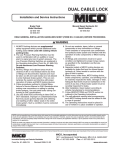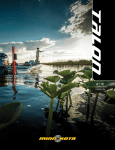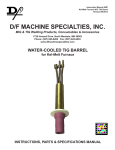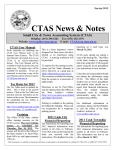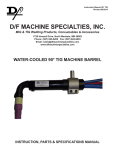Download 81-540-007 - MICO, Inc.
Transcript
MULTIPLE DISC BRAKE (liquid cooled - SAE C size) Service Manual MICO could not possibly know of and give advice with respect to all conceivable applications in which this product may be used and the possible hazards and/or results of each application. MICO has not undertaken any such wide evaluation. Therefore, anyone who uses an application which is not recommended by the manufacturer, first must completely satisfy himself that a danger will not be created by the application selected, or by the particular model of our product that is selected for the application. MICO has made every attempt to present accurate information in catalogs, brochures and other printed material. MICO can accept no responsibility for errors from unintentional oversights that may exist. Due to a continuous program of product improvement, materials, specifications, and product documentation are subject to change without notice or obligation. MICO is a registered trademark of MICO, Inc. MICO is registered in the U.S. Patent and Trademark Office as well as in Australia, Canada, Indonesia, Japan, Peoples Republic of China, South Korea, and the European Community. MICO, Incorporated Innovative Braking and Controls Worldwide Form No. 81-540-007 Revised 1997-11-01 1911 Lee Boulevard / North Mankato, MN U.S.A. 56003-2507 Tel: +1 507 625 6426 Fax: +1 507 625 3212 www.mico.com TYPICAL MULTIPLE DISC BRAKE (Model 02-540-060 shown) FIGURE 1 MICO, Inc. (2) Form No. 81-540-007 Revised 1997-11-01 DESCRIPTION AND OPERATION OF THE MICO MULTIPLE DISC BRAKE of the brake will start to initiate a brake application. Zero pressure produces maximum brake torque. Brake cooling is normally provided by one of the following methods: The MICO Multiple Disc Brake (liquid cooled) is designed specifically for use with heavy duty machinery, off-highway vehicles, construction, materials handling, mining equipment and in a multitude of winching applications. Models are available in standard SAE mounting flange styles. Other special mountings are also available. Contact MICO with your requirements. Sump Method Oil is added at the time of installation to a level of 1/4-1/2 capacity, 118.3-236.6 mL (4-8 fl oz). A breather must be installed on the top cooling port to compensate for expansion, due to heat. This method of cooling is used where the operation of the brake is strictly for parking or emergency use, i.e. either on or off with minimal dragging through the brake. Also the maximum shaft speed must not exceed 1500 rpm in this mode due to fluid viscous shear. This multiple disc brake provides consistent braking torque, positive hold, and long life in rugged environments. An oil bath protects the friction surfaces, dissipates heat efficiently and resists internal corrosion, thus providing high repeatability in performance. The brake will also reduce maintenance and downtime, because environmental contaminants which add to brake lining wear are restricted from entering the brake. Clean oil is a must for optimum lining life. Braking is provided by a pack of friction discs splined to the housing, and rotating discs splined to the drive shaft. Force is transmitted to the disc pack through a hydraulic piston and a series of preloaded springs. The brake is released by hydraulic pressure applied to the piston to compress the springs. The brake is selfapplying since any function which reduces the hydraulic system pressure below the release pressure Flow Through Method A continuous flow of oil between 3.79 and 30.3 L/min (1 and 8 GPM) from the vehicles hydraulic system is used for cooling. This method is required where the application may involve dragging through the brake such as in a winch application for positioning a load. Internal cooling pressure should be maintained below 6.9 bar (100 PSI). This method is also ideal for higher shaft speed applications. Repair Kits Model Number Lining Kit Number Bearing Kit Number 02-540-050 02-540-052 02-540-054 02-540-056 02-540-060 02-540-062 02-540-064 02-540-066 02-540-068 02-540-070 02-540-072 02-540-074 02-540-076 02-540-078 02-540-200 02-540-204 02-540-206 02-540-208 02-540-210 20-060-040 20-060-040 20-060-040 20-060-040 20-060-040 20-060-040 20-060-040 20-060-040 20-060-040 20-060-040 20-060-040 20-060-047 20-060-046 20-060-040 20-060-046 20-060-040 20-060-040 20-060-040 20-060-040 02-500-062 02-500-062 02-500-062 02-500-062 02-500-062 02-500-062 02-500-062 02-500-062 02-500-062 02-500-070 02-500-062 02-500-083 02-500-081 02-500-070 02-500-081 02-500-070 02-500-062 02-500-062 02-500-062 O-ring Kit Number * 02-500-061 02-500-064 02-500-063 02-500-064 * 02-500-061 02-500-064 02-500-063 02-500-064 02-500-087 02-500-069 02-500-063 02-500-082 02-500-080 02-500-069 02-500-080 02-500-069 02-500-105 02-500-087 02-500-063 * Same kit as 02-500-064 with the addition of seal (17) and retaining ring (19). All kits include mounting gasket. NOTE: Earlier models do not use spacer plate (15). Form No. 81-540-007 Revised 1997-11-01 (3) MICO, Inc. Model Numbers: 02-540-050 02-540-052 02-540-056 02-540-060 02-540-062 02-540-066 02-540-068 02-540-074 02-540-076 02-540-200 02-540-206 02-540-208 ASSEMBLY (Refer to Figure 2) LUBRICATE ALL RUBBER COMPONENTS FROM REPAIR KIT WITH CLEAN TYPE FLUID USED IN THE SYSTEM. REFER TO PAGE 3 FOR PROPER REPAIR KIT. 1. Clean all parts thoroughly before assembly. DISASSEMBLY NOTE (Refer to Figure 2) Follow step 2 only if seal (17) and retaining ring (19) are found in your brake during disassembly. 1. Remove end cover (3) from housing (18) by removing cap screws (1) and lock washers (2). 2. Insert new retaining ring (19) in housing (18). Press new seal (17) into housing (18) until it shoulders against retaining ring (19). Since cover is under spring tension of approximately 907 kgf (2000 lb), the six cap screws must be loosened evenly to relieve this force. If a hydraulic press is available, 2268 kgf (5000 lb maximum), the cover can be held in position while removing the cap screws and lock washers. NOTE Follow step 3 only if spacer plate (15) was found in your brake during disassembly. 3. Insert spacer plate (15) in housing (18). 4. Starting with one of nine new steel plates (13) and alternating with eight of the ten new friction plates (14), install them on shaft (6). 5. Install new bearing (16) on male end of shaft (6) and press until it shoulders on shaft. 6. Insert one of two remaining new friction plates (14) in housing (18). With shaft (6) positioned vertically (male end facing down), place shaft assembly in housing (18) aligning tabs with slots in housing. Carefully press shaft assembly into housing (18) until bearing shoulders on bottom of housing. Insert the last new friction plate (14) in housing (18). 7. Install new o-rings (9 & 11) and new back-up rings (8 & 12) on piston (10). Carefully push piston (10) into bore of housing (18) until piston bottoms on top of lining stack. 8. Insert springs (7) in piston (10). NOTE: Install springs (7) in same pattern as they were removed. 9. Press new bearing (5) in end cover (3). Install new o-ring (4) on flange of cover (3). 10. Position cover assembly on top of springs (7). Insert cap screws (1) and lock washers (2) through cover (3) and into housing (18). Tighten screws evenly to draw cover (3) to housing (18) and bearing (5) onto shaft (6). Torque cap screws (1) 74.6 N·m (55 lb·ft). 2. If necessary, tap cover with a soft mallet to dislodge bearing (5) from shaft (6). 3. Remove o-ring (4) from flange of cover (3). Press bearing (5) out of cover (3). 4. Remove springs (7) from piston (10). Remove piston (10) from housing (18) by inserting two 1/2-13 UNC bolts into threaded holes at bottom of spring pockets in piston (10). Using appropriate puller, remove piston (10) from bore of housing. Note quantity and pattern of springs (7) when removed. 5. Remove o-ring (9), back-up ring (8), o-ring (11) and back-up ring (12) from piston (10). 6. Remove shaft assembly consisting of shaft (6), plates (13), friction plates (14) and bearing (16) from housing (18) by pressing or using a soft mallet on male end of shaft (6). 7. Remove spacer plate (15) and bottom friction plate (14) from housing (18). NOTE: Earlier models do not use spacer plate (15). 8. Remove bearing (16) from end of shaft (6) with appropriate bearing puller. Remove steel plates (13) and friction plates (14) from male end of shaft (6). 9. Remove retaining ring (19) and press seal (17) from housing (18). NOTE: Not all models use seal (17) and retaining ring (19). NOTE A hydraulic press will simplify installation of cover on housing. Clamp cover in position while tightening the cap screws. 11. To eliminate binding on bearings, press on inner ring of bearing (5) until it shoulders on shaft (6). MICO, Inc. (4) Form No. 81-540-007 1997-11-01 s Items included in Lining Repair Kit l Items included in Bearing Repair Kit n Items included in O-ring Repair Kit * Not used on all models Form No. 81-540-007 Revised 1997-11-01 FIGURE 2 (5) MICO, Inc. Model Numbers: 02-540-054 02-540-064 02-540-070 02-540-072 02-540-078 02-540-204 02-540-210 ASSEMBLY (Refer to Figure 3) LUBRICATE ALL RUBBER COMPONENTS FROM REPAIR KIT WITH CLEAN TYPE FLUID USED IN THE SYSTEM. REFER TO PAGE 3 FOR PROPER REPAIR KIT. DISASSEMBLY 1. Clean all parts thoroughly before assembly. (Refer to Figure 3) 1. Remove end cover (3) from housing (18) by removing cap screws (1) and lock washers (2). NOTE Follow step 2 only if seal (17) and retaining ring (19) are found in your brake during disassembly. Since cover is under spring tension of approximately 907 kgf (2000 lb), the six cap screws must be loosened evenly to relieve this force. If a hydraulic press is available, 2268 kgf (5000 lb maximum), the cover can be held in position while removing the cap screws and lock washers. 2. Insert new retaining ring (19) in housing (18). Press new seal (17) into housing (18) until it shoulders against retaining ring (19). NOTE Follow step 3 only if spacer plate (15) was found in your brake during disassembly. 2. If necessary tap cover with a soft mallet to dislodge bearing (5) from shaft (6). 3. Remove o-ring (4) from flange of cover (3). Press bearing (5) out of cover (3). 4. Remove springs (7) from piston (9). Remove piston (9) from housing (18) by inserting two 1/2-13 UNC bolts into threaded holes at bottom of spring pockets in piston (9). Using appropriate puller, remove piston (9) from bore of housing. Note quantity and pattern of springs (7) when removed. 5. Use appropriate puller to remove sleeve (11). Remove o-rings (10 & 12) from sleeve (11). 6. Remove o-ring (8) from piston (9). 7. Remove shaft assembly consisting of shaft (6), plates (13), friction plates (14) and bearing (16) from housing (18) by pressing or using a soft mallet on male end of shaft (6). 8. Remove spacer plate (15) and bottom friction plate (14) from housing (18). NOTE: Earlier models do not use spacer plate (15). 9. Remove bearing (16) from end of shaft (6) with appropriate bearing puller. Remove plates (13) and friction plates (14) from male end of shaft (6). 10. Remove retaining ring (19) and press seal (17) from housing (18). NOTE: Not all models use seal (17) and retaining ring (19). 3. Insert spacer plate (15) in housing (18). 4. Starting with one of nine new steel plates (13) and alternating with eight of the ten new friction plates (14), install them on shaft (6). 5. Install new bearing (16) on male end of shaft (6) and press until it shoulders on shaft. 6. Insert one of two remaining new friction plates (14) in housing (18). With shaft (6) positioned vertically (male end facing down), place shaft assembly in housing (18) aligning tabs with slots in housing. Carefully press shaft assembly into housing (18) until bearing shoulders on bottom of housing. Insert the last new friction plate (14) in housing (18). 7. Install new o-rings (10 & 12) on sleeve (11). Carefully push sleeve (11) into bore of housing (18) until piston bottoms on housing bore. 8. Install new o-ring (8) on piston (9). Carefully push piston (9) into bore of housing (18) until piston bottoms on top of lining stack. 9. Insert springs (7) in piston (9). NOTE: Install springs (7) in the same pattern as they were removed. 10. Press new bearing (5) in end cover (3). Install new o-ring (4) on flange of cover (3). 11. Position cover assembly on top of springs (7). Insert cap screws (1) and lock washers (2) through cover (3) and into housing (18). Tighten screws evenly to draw cover (3) to housing (18) and bearing (5) onto shaft (6). Torque cap screws (1) 74.6 N·m (55 lb·ft). NOTE A hydraulic press will simplify installation of cover on housing. Clamp cover in position while tightening the cap screws. 12. To eliminate binding on bearings, press on inner ring of bearing (5) until it shoulders on shaft (6). MICO, Inc. (6) Form No. 81-540-007 Revised 1997-11-01 s Items included in Lining Repair Kit l Items included in Bearing Repair Kit n Items included in O-ring Repair Kit * Not used on all models Form No. 81-540-007 FIGURE 3 Revised 1997-11-01 (7) MICO, Inc. BLEEDING 1. Install brake in system and connect pressure lines as well as coolant lines if flow through cooling is used. 2. Bleed pressure release section of brake by pressurizing side inlet port and allowing air to escape from top port. Pressure should not exceed 6.9 bar (100 PSI) during bleeding. 3. Apply sufficient pressure to release brake and check for proper operation in system. SERVICE DIAGNOSIS (Refer to Figure 2) BRAKE WILL NOT RELEASE 1. Insufficient release oil pressure 2. Damaged o-rings (9 or 11) 3. Damaged o-ring (12), Figure 3 4. Damaged piston (10), Figure 2 5. Damaged bearings (5 or 16) 6. Plates (13 & 14) warped or welded together due to excessive heat MICO, Inc. BRAKE WILL NOT APPLY 1. Residual oil pressure in release section of brake 2. Damaged springs (7) 3. Damaged piston (10), Figure 2 4. Broken bolts (1) allowing cover (3) to move away from housing (18) (8) BRAKE APPLIES BUT TORQUE LOW 1. Residual oil pressure in release section of brake 2. Springs (7) have taken permanent set due to excessive heat 3. Friction plates (14) worn out OIL LEAKS EXTERNALLY FROM BRAKE 1. Damaged rotary oil seal (17) 2. Damaged o-ring (4) Form No. 81-540-007 Revised 1997-11-01








